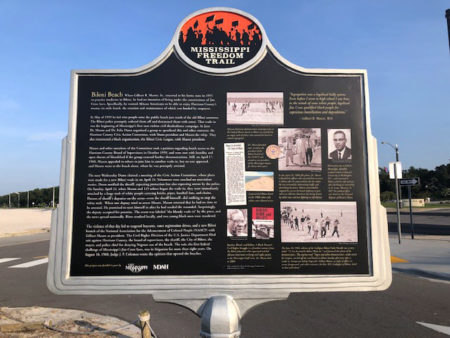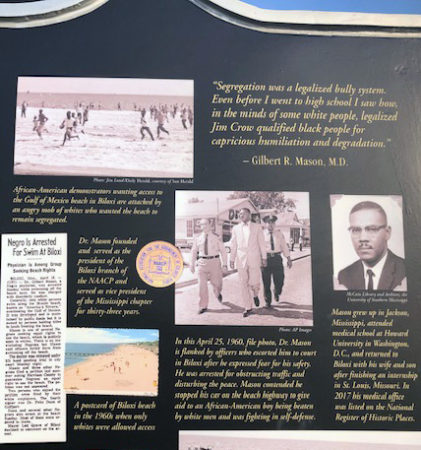In 1958 when six Sisters of Mercy from Birr and Nenagh were assigned to teach at Nativity School in Biloxi, Mississippi, we knew almost nothing about civil rights. Very soon we learned about the subject from our surroundings. We were shocked to find that the so-called Jim Crow Laws, which mandated strict segregation in all facilities, including our Catholic Churches and schools, still persisted. No black person could come to our church, and no black child was allowed to attend our school. Black Catholics worshipped at Our Mother of Sorrows Church on Division Street — note the name of the street! Children got a good education from the Blessed Sacrament Sisters (Mother Katharine Drexel’s Sisters) at the all-black Catholic School. But they did not get to come to our Nativity School until 1968.
Less than a year after our arrival, our awareness of civil rights issues was heightened by what came to be known as the Biloxi Beach Wade-Ins, which were civil rights demonstrations by African Americans in Biloxi in an effort to integrate the 26-mile beach stretching from Biloxi to the city of Bay St. Louis.

The first Wade-in was held on May 14th, 1959. A small protest, it was led by Dr. Gilbert Mason Sr., a black physician who had come down from Jackson, Mississippi to serve the black community on the Gulf Coast. Together he and nine others entered the beach area. During that event police told the participants: “Negroes don’t come to the sand beach,” and “You cannot swim here – we’re going to put you under arrest.” All nine participants were forcibly removed. Following the teachings of non-violence practiced by the Civil Rights movement, they did not resist arrest. Truthfully, I think we and the rest of the whites-only neighborhood were almost unaware of the event.
However, further demonstrations, especially the third Wade-in, did not pass us by. As the day for this protest approached people, both black and white, got nervous, fearing bloodshed. We Sisters were told by the Bishop not to participate, and in those days we obeyed the Bishop! I remember looking out the window of our convent which was located directly across from the beach, where about 125 participants had gathered.
It was April 24th, 1960, a day that became known as Bloody Sunday.
Unarmed black people who took part in the peaceful demonstration were hit with bricks, baseball bats, pipes, sticks and other weapons by whites, who swarmed the beach. We heard later that black neighborhoods were terrorized that night by car-loads of angry whites driving through the streets and firing guns.

On June 23rd, 1963, a fourth Wade-in was held by 75 demonstrators, including two white ministers. This time the group was protected by law enforcement officers as they protested! It seemed we were, slowly, coming into a new era in the South. In 1968, a federal court ruling opened the beaches to everyone.
Fast-forward 60 years to 2019, when organisers, supporters and participants returned to the very same spot to unveil a new exhibit. The exhibit is made up of large historical markers with photos, information, and timelines surrounding the Wade-ins and other prominent civil rights events that took place in South Mississippi. If we Irish Mercy Sisters had still been ministering there, we would certainly have been present at the opening of the Wade-in exhibit, filled with awe and admiration for the brave people who risked injury and imprisonment so that all might be able to enjoy the beautiful beach without fear of reprisal. It was one step forward in the long struggle for civil rights for people of colour.
The question might be asked, how did we Irish Mercy Sisters participate in the civil rights struggle of the 1960s? The biggest way was integrating our schools in Biloxi and Gulfport. In 1964, integration became a state law. The Diocese of Biloxi immediately complied with the law and every effort was made to integrate the schools. It was a slow and challenging process. Being part of the movement and teaching in our school there, I felt that the best thing for us to do was treat everybody with equal respect, and expect our pupils to do the same. But I do remember that our pastor was scared on that first day when the parish school opened its doors to black students. Only one black family came. Luckily, both the children of that family were good students and confident mixers. What pressure the poor children were under as the only representatives of their race in the school.
We gradually retired from our ministries in Mississippi, the last of us in 2015. Now, looking back on the 1960s we feel that it was our privilege to have lived in the South at a difficult time, and to have been able to witness the courage of those black neighbors who made the first break-throughs for civil rights.

The new racism today is experienced by the immigrants and refugees coming from Central and South America, who are not welcome in this country, and are being mistreated as they seek to live here. I am so upset with the manner in which our Government is treating them. I don’t know what will happen but all I can say is “Civil Rights” are far from being a reality for every person. As this crisis unfolds, we as Sisters of Mercy want to continue to play a role both in sheltering and in securing justice and acceptance for people on the margin.
Images by Dennis Burke
Mary Riordan rsm
US Region


